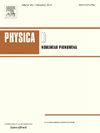Integrable nonlinear PDEs as evolution equations derived from multi-ion fluid plasma models
IF 2.7
3区 数学
Q1 MATHEMATICS, APPLIED
引用次数: 0
Abstract
Various types of nonlinear partial-differential equations (PDEs) have been proposed in relation with plasma dynamics. In a 1D geometry, a Korteweg–de Vries (KdV) equation can be derived from a plasma fluid model for electrostatic excitations, by means of the reductive perturbation technique proposed by Taniuti and coworkers in the 1960s (Washimi and Taniuti, 1966). In the simplest “textbook level” case of an electron–ion plasma, describing an ion fluid evolving against an electron distribution (assumed known), this integrable equation, incorporating a nonlinearity coefficient (say, ) and a dispersion coefficient (), possesses analytical soliton solutions, whose polarity depends on the sign of . In more elaborate plasma configurations, including a (one, or more) (negatively charged) secondary ion or/and electron population(s), a critical plasma composition where the quadratic nonlinearity term A is negligible may be possible: in this case, a modified KdV (mKdV) equation may be derived, where dispersion is balanced by a cubic nonlinearity term, leading to exact pulse-shaped soliton solutions. A third possible scenario occurs when, depending on the relative concentration between positive and negative ions in the plasma mixture, an extended KdV (i.e. a Gardner) equation may be obtained, allowing for both positive and negative soliton solutions.
In this study, we have revisited the reductive perturbation technique, using a generic bi-fluid (electronegative plasma) model as starting point, in an effort to elucidate the subtleties underlying the reduction of a fluid plasma model to a nonlinear evolution equation for the electrostatic (ES) potential. Considering different plasma compositions, different types of PDEs have been obtained, in specific regimes. We have thus studied the conditions for the existence of various types of pulse-shaped excitations (solitary waves) for the electrostatic potential, associated with bipolar electric field () waveforms, such as the ones observed in planetary magnetospheres and in laboratory experiments.
求助全文
约1分钟内获得全文
求助全文
来源期刊

Physica D: Nonlinear Phenomena
物理-物理:数学物理
CiteScore
7.30
自引率
7.50%
发文量
213
审稿时长
65 days
期刊介绍:
Physica D (Nonlinear Phenomena) publishes research and review articles reporting on experimental and theoretical works, techniques and ideas that advance the understanding of nonlinear phenomena. Topics encompass wave motion in physical, chemical and biological systems; physical or biological phenomena governed by nonlinear field equations, including hydrodynamics and turbulence; pattern formation and cooperative phenomena; instability, bifurcations, chaos, and space-time disorder; integrable/Hamiltonian systems; asymptotic analysis and, more generally, mathematical methods for nonlinear systems.
 求助内容:
求助内容: 应助结果提醒方式:
应助结果提醒方式:


